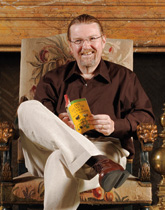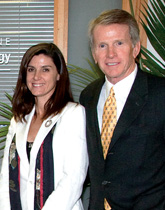Before leaving the American Museum of Natural History, 13-year-old Robert Murphy stops in the gift shop and asks his parents for a souvenir from the day's trip to the Manhattan museum. When his parents acquiesce, Murphy picks outs two paperbacks: the first is a book on space exploration, the second a book on human genetics. As soon as Murphy and his parents return to their home in Long Island's New Hyde Park, Murphy quickly reads his new treasures. He first reads the space exploration book and after finishing, thinks, "Wow, that's really great."

But something in him changes when he reads the second book, The Genetic Code by Isaac Asimov.
"I knew then exactly what I wanted to do with my life," Murphy says. "I came downstairs and told my folks, 'I want to do biomedical research. I want to do genetics. I want to understand this kind of stuff.'"
When he attends Columbia University, he studies biochemistry, but he feels that something is lacking in his research. He goes on to the California Institute of Technology where he works toward his PhD in biochemistry and wonders how he can find better and faster ways to analyze the data from his biological experiments. He seeks advice from another grad student, who tells him to try using some mathematical techniques, such as fitting the data to curves. He also mentions that the school's computing center might be helpful.
Murphy has another epiphany. He realizes that he can use computers—primarily a tool only for engineers at the time—to analyze the data of his biological experiments. "I was immediately fascinated at the thought," he says.
In the early 1980s, Murphy brought to Carnegie Mellon this enthusiasm for automated analysis. Specifically, a 1982 ad for the Center for Fluorescence Research motivated him to apply for a faculty position in the Mellon College of Science. The ad described the creation of a center that would focus on using fluorescence methods to describe cell behavior. He was intrigued by the university's interdisciplinary approach, and especially the potential for utilizing computer science in biomedical research. Murphy believed that computational analysis of cell behavior might eventually lead to cures for a host of diseases.
Solving big problems, such as diseases, is something Raymond J. Lane can appreciate. In fact, he helps find solutions for a living as the general partner of Kleiner, Perkins, Caufield and Byers, a Silicon Valley venture capital firm. That problem-solving trait isn't just related to business for Lane. He is looking for answers for what has happened to his family. He was just 18 years old when he lost his father to cancer, and all of his paternal aunts and uncles met the same fate. The thought of finding a cure for cancer challenges him.

It's a challenge he shares with his wife. Stephanie Lane sits on the board of the American Cancer Society in California and seeks international funding to curb cancer, including working with the Chinese health minister to create the smoke-free Olympic park in Beijing.
From enduring personal tragedy to recognizing cancer's international impact, the Lanes realize that the illness is one of the medical field's biggest problems. "But most lead scientists believe it can be solved within a matter of decades," Ray Lane points out. "So if we know it can be solved, it's not a question of research, but of speed with which it can be solved."
Here's where the lives of the Lanes and Bob Murphy intertwine. Lane, a member of the university's Board of Trustees, and his wife were looking to be early contributors to the historic capital campaign: Inspire Innovation: The Campaign for Carnegie Mellon University. Lane chairs this endeavor to raise $1 billion by June 30, 2013 (see News Flash: Inspire Innovation). When he and his wife met Murphy—at that point a professor of biological sciences, biomedical engineering, and machine learning—they realized he could fill a void in cancer research.
The Lanes learned that Murphy's expertise, which blends biomedical experiments with computerized analysis, is the important next step in improving treatment and finding a cure. "There are a lot of researchers and a lot of doctors spending time doing research in areas beyond human computational ability," Lane says.
Murphy agrees. "If people can't really hold in their heads an accurate predictive model of even small pieces of biological systems, then we can't make accurate predictions about what those systems are going to do in disease, under different genetic backgrounds, under different environmental conditions. If we get to the point when people can't do that task, then who's going to do it? That's where computers come in."
For this important next step, Murphy has been named the director of the Ray and Stephanie Lane Center for Computational Biology. The center opened last September through a $5 million gift from the Lanes. The gift also provides support for doctoral and post-doctoral training and endows a professorship. Murphy is the first appointee. Already, Murphy has been hard at work. After selecting three post-doctoral fellows, he has begun creating automated and detailed predictive models of cells' behavior—one of the goals of the Lane Center—which scientists can use to analyze and to better understand the behavior of a particular patient's illness.
A disease's characteristic course often breaks down, says Murphy. Cancer, for instance, behaves in an individualized fashion, based on a patient's genes, environmental exposure, and individual medical history. By looking at images of multiple cell types and analyzing their different patterns, computers can identify such breakdowns more quickly than the human eye.
For example, as Murphy and his team perfect systems capable of examining different tissues, their technology will enable others to identify with unparalleled accuracy the parts of cells where cancerous proteins lie. By determining the exact locations of cancer-associated proteins, researchers and doctors can better diagnose the disease and advance treatment for patients.
The scope of the Lane Center extends beyond cancer research, but it remains a primary objective for the Lanes and for Murphy, who says the challenge motivates him much like The Genetic Code did decades ago. "Cancer is an incredibly complex series of diseases, and it's this combination of societal impact and its complexity, from my perspective, that makes it something very compelling to work on," Murphy says.
Brittany McCandless (HS'08) is one of only two recipients of the 2007 Newspaper Guild of Pittsburgh scholarship.



